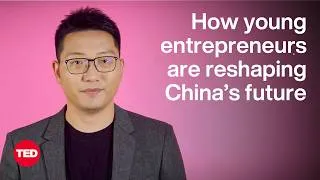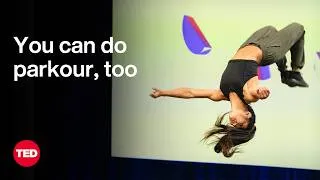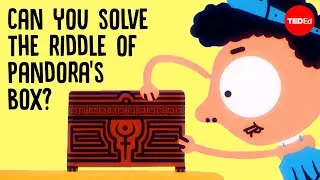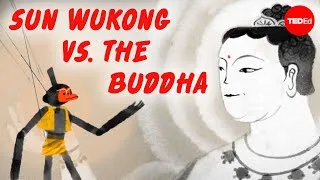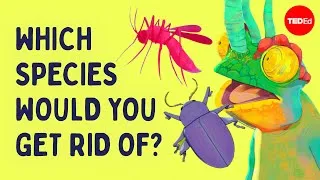The secret weapon that let dinosaurs take over the planet | Emma Schachner
120,008 views ・ 2020-01-28
請雙擊下方英文字幕播放視頻。
00:00
Translator: Joseph Geni
Reviewer: Camille Martínez
0
0
7000
譯者: Lilian Chiu
審譯者: Helen Chang
00:13
We've all heard about
how the dinosaurs died.
1
13016
2428
我們都聽過恐龍是怎麼滅絕的。
00:16
The story I'm going to tell you
2
16285
1953
我要告訴各位的故事
00:18
happened over 200 million years
before the dinosaurs went extinct.
3
18262
4612
發生的時間至少在
恐龍絕種前兩億年。
00:23
This story starts at the very beginning,
4
23481
2886
故事開始於最早的時期,
00:26
when dinosaurs were just
getting their start.
5
26391
2345
恐龍剛剛發跡時。
00:29
One of the biggest mysteries
in evolutionary biology
6
29269
2725
演化生物學中最大的謎題之一
00:32
is why dinosaurs were so successful.
7
32018
3014
就是為什麼恐龍能如此成功。
00:35
What led to their global dominance
for so many years?
8
35548
3759
是什麼讓牠們能
主宰全球這麼多年?
00:39
When people think about
why dinosaurs were so amazing,
9
39896
3518
談到為什麼恐龍如此了不起時,
00:43
they usually think about the biggest
or the smallest dinosaur,
10
43438
3805
通常大家會想到最大或最小的恐龍,
00:47
or who was the fastest,
11
47267
1445
或者哪種恐龍最快,或羽毛最多,
00:48
or who had the most feathers,
12
48736
1568
00:50
the most ridiculous armor,
spikes or teeth.
13
50328
2906
或者最可笑的裝甲、尖刺,或牙齒。
00:54
But perhaps the answer had to do
with their internal anatomy --
14
54126
3984
但也許,答案和牠們的
內部解剖結構有關——
00:58
a secret weapon, so to speak.
15
58134
2192
可以說是一種秘密武器。
01:00
My colleagues and I,
we think it was their lungs.
16
60716
3707
我和我同事認為
關鍵在牠們的肺部。
01:05
I am both a paleontologist
and a comparative anatomist,
17
65149
4254
我是古生物學家,
也是比較解剖學家,
01:09
and I am interested in understanding
18
69427
1945
我感興趣的是了解
01:11
how the specialized dinosaur lung
helped them take over the planet.
19
71396
3409
特殊化的恐龍肺部
如何協助牠們掌管地球。
01:15
So we are going to jump back
over 200 million years
20
75797
3701
所以,我們要回到超過兩億年前,
01:19
to the Triassic period.
21
79522
1753
三疊紀時期。
01:21
The environment was extremely harsh,
22
81299
2392
當時的環境非常嚴酷,
01:23
there were no flowering plants,
23
83715
1640
沒有會開花的植物,
01:25
so this means that there was no grass.
24
85379
2255
這就表示也沒有草。
01:27
So imagine a landscape
filled with all pine trees and ferns.
25
87658
4398
想像一片滿是松樹
和蕨類植物的地景,
01:32
At the same time,
there were small lizards,
26
92587
3453
同時,還有小型蜥蜴、
01:36
mammals, insects,
27
96064
2391
哺乳類動物、昆蟲,
01:38
and there were also carnivorous
and herbivorous reptiles --
28
98479
4314
還有肉食性和草食性的爬蟲類——
01:42
all competing for the same resources.
29
102817
2287
全都要競爭搶奪同樣的資源。
01:45
Critical to this story
30
105454
1541
對這個故事很重要的一點是
01:47
is that oxygen levels have been estimated
to have been as low as 15 percent,
31
107019
5328
估計當時的氧含量只有 15% 這麼低,
01:52
compared to today's 21 percent.
32
112371
2153
相對之下,現今是 21%。
01:54
So it would have been crucial
for dinosaurs to be able to breathe
33
114932
3587
所以,很重要的是,恐龍要能夠
在這種低氧的環境中呼吸,
01:58
in this low-oxygen environment,
34
118543
1875
02:00
not only to survive
35
120442
1855
不僅要能生存,
02:02
but to thrive and to diversify.
36
122321
2689
還要能茁壯和產生多樣性。
02:06
So, how do we know
what dinosaur lungs were even like,
37
126462
3097
那麼,我們要怎麼知道
恐龍的肺部是什麼樣子,
02:09
since all that remains of a dinosaur
generally is its fossilized skeleton?
38
129583
5133
畢竟恐龍留下來的部分
通常都只是骨骼的化石?
02:15
The method that we use is called
"extant phylogenetic bracketing."
39
135257
5092
我們用的方法叫做
「延伸親緣包圍法」。
02:21
This is a fancy way of saying
that we study the anatomy --
40
141085
4045
這是種很炫的說法,其實意思
就是我們會去研究解剖結構——
02:25
specifically in this case,
the lungs and skeleton --
41
145154
3576
在這個例子中,
是研究肺部和骨骼——
02:28
of the living descendants of dinosaurs
on the evolutionary tree.
42
148754
3978
從恐龍的演化樹上找出
現存的後裔來當研究對象。
02:33
So we would look at the anatomy of birds,
43
153235
2964
所以,我們會研究
鳥類的解剖結構,
02:36
who are the direct
descendants of dinosaurs,
44
156223
2858
鳥類是恐龍的直屬後裔,
02:39
and we'd look at
the anatomy of crocodilians,
45
159105
2349
我們會去研究鱷魚類
動物的解剖結構,
02:41
who are their closest living relatives,
46
161478
1948
牠們是恐龍最近的活親戚,
02:43
and then we would look at
the anatomy of lizards and turtles,
47
163450
2993
接著,我們會研究
蜥蜴和烏龜的解剖結構,
02:46
who we can think of like their cousins.
48
166467
2605
我們可以把牠們視為恐龍的表親。
02:49
And then we apply these anatomical data
to the fossil record,
49
169096
3436
接著,我們把這些解剖學
資料套用到化石記錄上,
02:52
and then we can use that
to reconstruct the lungs of dinosaurs.
50
172556
3643
然後,我們就可以依此
重新建造出恐龍的肺部。
02:56
And in this specific instance,
51
176223
2044
在這個特殊的例子中,
02:58
the skeleton of dinosaurs most closely
resembles that of modern birds.
52
178291
4914
恐龍的骨骼最接近現代鳥類。
03:03
So, because dinosaurs were competing with
early mammals during this time period,
53
183696
4766
因為,在這個時期,
恐龍要和早期的哺乳類競爭,
03:08
it's important to understand
the basic blueprint of the mammalian lung.
54
188486
3659
很重要的是要了解
哺乳類肺部的基本藍圖。
03:12
Also, to reintroduce you
to lungs in general,
55
192597
2834
此外,為了讓各位
對肺部有一般性的了解,
03:15
we will use my dog Mila of Troy,
56
195455
2635
我們要用我的狗,
特洛伊的米拉(標誌),
03:18
the face that launched a thousand treats,
57
198114
2040
牠的臉出現在一千種
市面上的零食上,
03:20
as our model.
58
200178
1219
用牠來當我們的模型。
03:21
(Laughter)
59
201421
1583
(笑聲)
03:23
This story takes place
inside of a chest cavity.
60
203028
3736
這個故事發生在胸腔內。
03:26
So I want you to visualize
the ribcage of a dog.
61
206788
3197
請各位視覺化想像狗的胸廓。
03:30
Think about how
the spinal vertebral column
62
210009
2457
想想看牠的脊柱
03:32
is completely horizontal to the ground.
63
212490
3269
完全和地面呈水平。
03:35
This is how the spinal
vertebral column is going to be
64
215783
2575
在我們等下要談的所有動物身上,
脊柱都是這個樣子的,
03:38
in all of the animals
that we'll be talking about,
65
218382
2406
03:40
whether they walked on two legs
66
220812
1498
不論是用兩隻腳或四隻腳走路。
03:42
or four legs.
67
222334
1153
03:43
Now I want you to climb inside
of the imaginary ribcage and look up.
68
223511
4514
現在,請各位爬入
想像的胸廓中,向上看。
03:48
This is our thoracic ceiling.
69
228944
2075
這是胸腔的頂部。
03:51
This is where the top surface of the lungs
comes into direct contact
70
231480
3919
肺部的上表面會直接接觸到
肋骨和脊椎骨的這個地方。
03:55
with the ribs and vertebrae.
71
235423
2325
03:58
This interface is where
our story takes place.
72
238374
3489
我們的故事就始於這個交界面。
04:02
Now I want you to visualize
the lungs of a dog.
73
242398
3035
現在,請各位視覺化想像狗的肺部。
04:05
On the outside, it's like
a giant inflatable bag
74
245457
3188
它的外部就像是一個
巨大的可充氣袋子,
04:08
where all parts of the bag
expand during inhalation
75
248669
3411
在吸氣時,袋子的各部分都會擴張,
04:12
and contract during exhalation.
76
252104
2473
在吐氣時會收縮。
04:14
Inside of the bag, there's a series
of branching tubes,
77
254601
3277
袋子內部,有一連串分歧的管子,
04:17
and these tubes are called
the bronchial tree.
78
257902
2483
這些管子叫做支氣管樹。
04:20
These tubes deliver the inhaled oxygen
to, ultimately, the alveolus.
79
260899
6115
吸入的氧氣
最終會被這些管子送到肺泡。
04:27
They cross over a thin membrane
into the bloodstream by diffusion.
80
267038
5042
它們會透過擴散的方式,
穿過薄膜進入血液中。
04:32
Now, this part is critical.
81
272572
2178
這部分十分關鍵。
04:35
The entire mammalian lung is mobile.
82
275440
3485
哺乳類的整個肺部都是移動式的。
04:38
That means it's moving
during the entire respiratory process,
83
278949
5018
意思就是,在整個
呼吸過程中它都在動,
04:43
so that thin membrane,
the blood-gas barrier,
84
283991
2586
因此,這片薄膜:血液-氣體屏障,
04:46
cannot be too thin or it will break.
85
286601
3035
不能太薄,不然就會破裂。
04:49
Now, remember the blood-gas barrier,
because we will be returning to this.
86
289660
3542
請記著這片血液-氣體屏障,
我們等下會再談到它。
04:53
So, you're still with me?
87
293721
1485
各位還在吧?
04:55
Because we're going to start birds
and it gets crazy,
88
295230
2628
因為我們要開始談鳥類,
這部分會很讓人抓狂。
04:57
so hold on to your butts.
89
297882
1440
所以,坐穩了。
04:59
(Laughter)
90
299346
1605
(笑聲)
05:01
The bird is completely different
from the mammal.
91
301648
3255
鳥類和哺乳類完全不同。
05:05
And we are going to be
using birds as our model
92
305495
2393
而我們要用鳥類來當模型,
05:07
to reconstruct the lungs of dinosaurs.
93
307912
2431
重新建造出恐龍的肺部。
05:10
So in the bird,
94
310367
1564
在鳥類體內,
05:11
air passes through the lung,
but the lung does not expand or contract.
95
311955
4217
空氣會穿過肺部,
但肺部不會擴張或收縮。
05:16
The lung is immobilized,
96
316707
1941
肺部不會動,
05:18
it has the texture of a dense sponge
97
318672
2292
它的材質就像是密實的海綿,
05:20
and it's inflexible and locked into place
on the top and sides by the ribcage
98
320988
5207
它沒有彈性,
且被胸廓從上方和側邊
固定在一個位置,
05:26
and on the bottom
by a horizontal membrane.
99
326219
3094
底部則是被一片水平的薄膜固定。
05:30
It is then unidirectionally ventilated
100
330300
3086
接著,它會單方向通氣,
05:33
by a series of flexible,
bag-like structures
101
333410
3988
方式是透過支氣管樹分枝出來的
05:37
that branch off of the bronchial tree,
102
337422
2788
一連串彈性袋狀結構,
05:40
beyond the lung itself,
103
340234
1588
這些結構在肺部外面,叫做氣囊。
05:41
and these are called air sacs.
104
341846
1870
05:44
Now, this entire extremely delicate setup
is locked into place
105
344249
5358
這整個非常精緻的機構,
被一組交叉的肋骨固定住,
05:49
by a series of forked ribs
106
349631
3189
05:52
all along the thoracic ceiling.
107
352844
2705
這些肋骨全都沿著胸腔頂部排列。
05:55
Also, in many species of birds,
108
355573
3082
在許多鳥類物種當中,
05:58
extensions arise from the lung
109
358679
2424
肺部和氣囊會產生出延伸物,
06:01
and the air sacs,
110
361127
1546
06:02
they invade the skeletal tissues --
111
362697
2608
它們會入侵到骨骼組織——
06:05
usually the vertebrae,
sometimes the ribs --
112
365329
2702
通常是脊椎,有時是肋骨——
06:08
and they lock the respiratory
system into place.
113
368055
2959
它們會把呼吸系統固定好。
06:11
And this is called
"vertebral pneumaticity."
114
371038
3436
這就叫做「脊椎氣腔」。
06:14
The forked ribs and
the vertebral pneumaticity
115
374498
3242
交叉的肋骨和脊椎氣腔
06:17
are two clues that we can hunt for
in the fossil record,
116
377764
3517
是我們能在化石記錄中
獵尋的兩條線索,
06:21
because these two skeletal traits
117
381305
2589
因為這兩項骨骼特性
06:23
would indicate that regions
of the respiratory system of dinosaurs
118
383918
4719
就代表恐龍的呼吸系統區域
06:28
are immobilized.
119
388661
1674
是不會動的。
06:33
This anchoring of the respiratory system
120
393200
2606
呼吸系統被固定住,
06:35
facilitated the evolution
of the thinning of the blood-gas barrier,
121
395830
3907
促使血液-氣體屏障演化,
變得越來越薄,
06:39
that thin membrane over which oxygen
was diffusing into the bloodstream.
122
399761
6099
也就是氧氣擴散到血液中時
要穿過的那層薄膜。
06:46
The immobility permits this
because a thin barrier is a weak barrier,
123
406746
5891
因為這層薄屏障並不堅固,
要系統固定不動才有可能如此,
06:52
and the weak barrier would rupture
if it was actively being ventilated
124
412661
4808
如果系統會主動通氣,
這片不堅固的屏障就會破裂,
06:57
like a mammalian lung.
125
417493
1815
像在哺乳類的肺部一樣。
07:00
So why do we care about this?
126
420056
1533
所以,我們為何要在乎這點?
這有什麼重要的?
07:01
Why does this even matter?
127
421613
1724
07:04
Oxygen more easily diffuses
across a thin membrane,
128
424083
4255
氧氣比較容易透過薄膜擴散,
07:09
and a thin membrane is one way
of enhancing respiration
129
429536
6091
且,
在低氧的條件下,
薄膜是強化呼吸的一種方式——
07:15
under low-oxygen conditions --
130
435651
2336
07:18
low-oxygen conditions
like that of the Triassic period.
131
438011
4581
比如三疊紀時期的條件
就是低氧的條件。
07:23
So, if dinosaurs did indeed
have this type of lung,
132
443425
4705
所以,如果恐龍確實有這種肺部,
07:28
they'd be better equipped to breathe
than all other animals,
133
448154
4057
牠們的呼吸能力
就會比其他動物更好。
07:32
including mammals.
134
452235
2134
包括哺乳類。
07:34
So do you remember the extant
phylogenetic bracket method
135
454851
3615
各位還記得延伸親緣包圍法嗎?
07:38
where we take the anatomy
of modern animals,
136
458490
2879
也就是把現代動物的解剖結構
07:41
and we apply that to the fossil record?
137
461393
2535
應用到化石記錄上?
07:43
So, clue number one
was the forked ribs of modern birds.
138
463952
4862
所以,第一條線索是
現代鳥類的交叉肋骨。
07:48
Well, we find that in pretty much
the majority of dinosaurs.
139
468838
4411
我們在大多數的恐龍身上
都找到這條線索。
07:53
So that means that the top surface
of the lungs of dinosaurs
140
473734
4797
這就表示,恐龍肺部的上表面
07:58
would be locked into place,
141
478555
2314
會被固定住,
08:00
just like modern birds.
142
480893
2952
就像現代鳥類一樣。
08:03
Clue number two is vertebral pneumaticity.
143
483869
3537
第二條線索是脊椎氣腔。
08:07
We find this in sauropod dinosaurs
and theropod dinosaurs,
144
487430
4807
我們在蜥腳下目及獸腳亞目
恐龍身上都有找到,
08:12
which is the group that contains
predatory dinosaurs
145
492261
3275
這些恐龍包括了掠食性恐龍,
08:15
and gave rise to modern birds.
146
495560
2222
並導致現代鳥類的出現。
08:18
And while we don't find evidence
of fossilized lung tissue in dinosaurs,
147
498250
5339
雖然我們沒有找到恐龍的
肺組織化石來當作證據,
08:23
vertebral pneumaticity gives us evidence
of what the lung was doing
148
503613
4549
脊椎氣腔給我們證據證明
這些動物活著的時候肺部如何運作。
08:28
during the life of these animals.
149
508186
2452
08:31
Lung tissue or air sac tissue
was invading the vertebrae,
150
511211
5345
肺部組織或氣囊組織在入侵脊椎,
08:36
hollowing them out
just like a modern bird,
151
516580
2507
掏空它們,就像現代鳥類一樣,
08:39
and locking regions
of the respiratory system into place,
152
519111
4134
把呼吸系統區域固定住,
08:43
immobilizing them.
153
523269
1600
讓它們無法動彈。
08:46
The forked ribs
154
526138
1785
交叉的肋骨
08:47
and the vertebral pneumaticity together
155
527947
2844
再加上脊椎氣腔
08:50
were creating an immobilized,
rigid framework
156
530815
4907
可以創造出不會動的堅硬框架,
08:55
that locked the respiratory
system into place
157
535746
2942
把呼吸系統固定好,
08:58
that permitted the evolution of that
superthin, superdelicate blood-gas barrier
158
538712
5774
因而能夠演化出超級薄、
超級細緻的血液-氣體屏障,
09:04
that we see today in modern birds.
159
544510
2856
也就是現代鳥類體內的那種。
09:07
Evidence of this straightjacketed
lung in dinosaurs
160
547390
3490
證明恐龍具有被束縛的肺部,
09:10
means that they had
the capability to evolve a lung
161
550904
3474
就意味著牠們有能力
可以讓肺部演化,
09:14
that would have been able to breathe
162
554402
1738
讓他們能夠在三疊紀時代的
09:16
under the hypoxic, or low-oxygen,
atmosphere of the Triassic period.
163
556164
5119
低氧大氣中呼吸。
09:21
This rigid skeletal setup in dinosaurs
would have given them
164
561981
5097
恐龍體內這種堅硬的骨骼結構
讓牠們在適應上比其他動物
09:27
a significant adaptive advantage
over other animals, particularly mammals,
165
567102
5483
(特別是哺乳類)有明顯優勢,
09:32
whose flexible lung couldn't have adapted
166
572609
2701
其他動物的肺部有彈性,
09:35
to the hypoxic, or low-oxygen,
atmosphere of the Triassic.
167
575334
3795
無法適應三疊紀時代的低氧大氣。
09:39
This anatomy may have been
the secret weapon of dinosaurs
168
579664
5070
這項解剖結構可能是
恐龍的秘密武器,
09:44
that gave them that advantage
over other animals.
169
584758
2944
讓牠們比其他動物更有優勢。
09:48
And this gives us an excellent launchpad
170
588096
2804
這也讓我們有很好的基礎,
09:50
to start testing the hypotheses
of dinosaurian diversification.
171
590924
4908
可以開始測試恐龍多樣化的假設。
09:55
This is the story of
the dinosaurs' beginning,
172
595856
3894
這個故事講的是恐龍的起源,
09:59
and it's just the beginning of the story
of our research into this subject.
173
599774
4498
就我們對這個主題的研究而言,
這個故事只是個開端而已。
10:04
Thank you.
174
604932
1192
謝謝。
10:06
(Applause)
175
606148
2961
(掌聲)
New videos
Original video on YouTube.com
關於本網站
本網站將向您介紹對學習英語有用的 YouTube 視頻。 您將看到來自世界各地的一流教師教授的英語課程。 雙擊每個視頻頁面上顯示的英文字幕,從那裡播放視頻。 字幕與視頻播放同步滾動。 如果您有任何意見或要求,請使用此聯繫表與我們聯繫。
